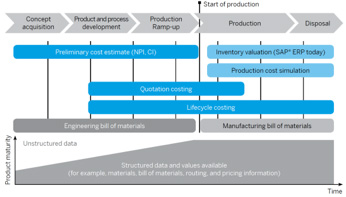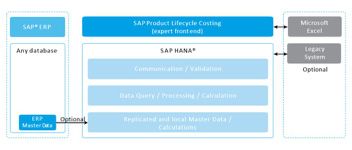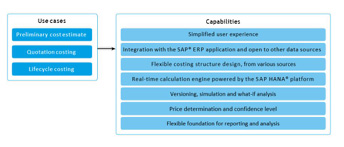Key takeaways:
- Effective, early product costing, especially for manufacturers in the automotive, industrial machinery, and high-tech industries is becoming more critical to a company’s ability to propose, deliver, and service the products that are key to their long-term profitably
- Effective lifecycle costing must incorporate the mechanical, electronic, and software components of today’s increasingly complex products as well as production, service, and other factors
- The SAP Product Lifecycle Costing solution enables companies to better manage product costs and quotations in line with strategic targets, especially during the bid and early development phases where design is evolving and master data is incomplete
Introduction
Product complexity in all industries is increasing. Products are becoming more “personalized” or configured to individual customer and functional needs. They are incorporating more electronics and software, and are being designed to meet ever-increasing demands for easy to use functionality, higher quality, at lower prices. This is pressuring manufacturers to make fast, early, accurate estimates of the cost of developing, producing, and servicing their products.
The ability for companies to quickly estimate and quote costs accurately is important for New Product Development and Introduction (NPDI) processes of automotive suppliers and OEMs as well as manufacturers of subcontracted or highly engineered products, as in high-tech electronics or industrial machinery industries. Faster response time and cost estimate accuracy are critical to a company’s ability to propose and deliver profitable products and business. However, the ability to make early, accurate product lifecycle cost estimates—estimates that must address mechanical, electronic, software elements of a product as well as production, service, logistics, etc.—is not generally available within most enterprises.
Most companies are using MS Excel spreadsheets or individual, siloed databases (e.g., built on Microsoft Access) to estimate costs, particularly during the proposal process and the early development stages. Generally, there is limited or no effective integration between relevant business systems that contain and manage cost related information (PDM, ERP, CRM, financial reporting, etc.) even though those systems often contain relevant price sources that could be easily used. There is also a need to exchange and collaborate on cost information among the various involved stakeholders not only by phone and email but using common business systems. In addition to fragmented data, most of the costing tools in use today are not flexible or adaptable enough. Customer requested changes to products are difficult to handle and it can be hard to find and reuse previous estimates that may be pertinent to the latest quotation.
The bottom line—it is difficult to accurately and quickly respond to requests for quotations for configured or engineered products and ensure that the work and product can be delivered profitably. Failure in this regard can cause loss of the business opportunity or quoting a project or product that will lose money regardless of how good or successful the product is.
What is Needed
CIMdata believes that to be successful, companies need to be able to estimate and analyze a product’s lifecycle costs including the long-term impact of upgrades and services early in the bid and development phases of the lifecycle. These estimates must incorporate costs from components (mechanical, electronic, software), materials, design and development, assembly and manufacturing, validation, and service. Cost information is defined and maintained in a diverse set of tools and repositories so cost estimating applications must be able to use unstructured as well as structured cost data. To ensure completeness and up-to-date accuracy of cost data, seamless integration with the many cost information sources, e.g., ERP, PLM, costing programs, suppliers, and others, is required.
To perform effective cost estimating and analysis, companies need to be able to create and maintain costed Bills of Materials (BOM). These BOMs need to include all the costing components and factors. Cost estimators then need to be able to compare costs and cost BOMs for each of the possible product/system options being evaluated. Additionally, estimators and sales teams need to have access to cost estimates for previous product configuration so they can be reused or modified as appropriate. The following figure presents the elements of product costing throughout the lifecycle.

Figure 1–Elements of Product Lifecycle Costing Spans the Entire Product Lifecycle
Personnel involved in the costing process need to be able to easily and rapidly communicate and collaborate to discuss and evaluate costing strategies and issues and to access the information they need to make informed costing decisions. Further, whenever some costing factor changes, i.e., material, assembly, design, service, etc., all impacted personnel and related cost systems and information need to be updated in a consistent manner.
Early Product Lifecycle Costing Benefits
There are many benefits that early and accurate lifecycle costing can deliver. Companies can more accurately calculate against target cost and mitigate quoting and NPDI financial risks. By being able to accurately calculate against their target cost, they can shorten their quotation cycles, make more accurate quotes, and achieve a faster response to requests for quotations. Using better product costing solutions can help a company integrate cost processes across divisions and increase collaboration between costing personnel and other functions.
The ability to more accurately calculate target cost can help reduce the cost of product development by avoiding spending valuable resources developing unprofitable product variants. In addition to new developments, costing analyses can be applied to product changes to ensure their profitability. Thus, the company will have a better ability to innovate and perform in today’s rapidly changing business environments.
The end result is that better product lifecycle costing can help a company increase their quote win rate, more accurately estimate the cost of new projects, and importantly, help ensure that “wins” are profitable. To address this need, new products are becoming available, each providing a range of capabilities that address aspects of the costing problem. SAP Product Lifecycle Costing (PLC) is one of the most comprehensive solutions for costing CIMdata has seen to date.
SAP Product Lifecycle Costing Highlights
Available today, SAP’s PLC solution is a purpose-built end-to-end application for early engineering, quotation, and lifecycle costing. SAP worked with several clients across the globe and from a variety of manufacturing industry segments to ensure that SAP PLC both addresses their cost estimating requirements but also that it provides the user experience that costing personnel desire.

Figure 2–SAP Product Lifecycle Costing Solution Architecture
To deliver the maximum functionality and flexibility, PLC is built on SAP HANA and incorporates a high-performance, real-time calculation engine that enables a company to perform comprehensive, complex lifecycle cost estimating and analysis. Each customer can implement their business-specific sourcing and pricing strategies. It provides a single version of the truth for real-time visibility into drivers of cost for all personnel working with or needing cost information. It incorporates full SAP security, locking, and versioning to ensure that sensitive cost information is protected. With its own master data management capability, PLC can be implemented as a standalone solution. It does not require implementation of SAP ERP, but it can leverage the master data available there and can be used it in combination with local PLC master data. For those companies that have deployed SAP solutions, PLC’s integration with them expands its capabilities and usefulness. MS Excel import and XML interfaces enable easy integration into existing cost management environments and applications.
Users can create and maintain multiple versions of costed BOMs based on different sources such as MS Excel, ERP Manufacturing BOM (MBOM), or an Engineering BOM (EBOM) from a CAD or PLM solution. It is designed to obtain structures (cost and product) from multiple sources. It incorporates native inbound and outbound integrations with SAP’s ERP and PLM data structures.
The PLC solution calculates bottom up and provides a variety of cost rollups and reports. It supports flexible, hierarchical product costing structures. Companies can perform what-if scenario and other analyses to make smarter and better design, production, supply chain, sourcing, and service decisions based on alternative product structures, cost rates, or quantities.
Customers can extend and tailor the solution in three different ways; leveraging Back-End APIs, Front-End Plug-Ins, or customer-specific fields and formulas framework. They can also define multiple cost factors including materials, labor, task routings, manufacturing overhead, etc. For ease of use by different personnel, the solution incorporates a modern role-based, configurable, and personalize-able user interface with a familiar spreadsheet-like paradigm. It provides three main views for users:
- Calculation view—to maintain and analyze calculation versions
- Cockpit view—to manage calculations
- Administration or master data view—to manage master data
SAP Product Lifecycle Costing provides the functionality, extensibility, and usability to enable companies to do more complete cost analysis and planning earlier in the product lifecycle. Figure 3 provides examples of the use cases that PLC supports.

Figure 3–Product Lifecycle Costing Use Cases
Summary
Companies are facing increasing pressure to design, deliver, and service innovative, customer-driven products at competitive prices. The inability to develop complete and accurate early product lifecycle cost models, and provide visibility and transparency to the costs included in them, hurts both development and down stream profitability. Companies need new, innovative lifecycle costing solutions to address these issues.
SAP’s PLC enables new product costs to be defined, quantified, and analyzed during the early stages of the product lifecycle (i.e., during development). SAP’s PLC solution can address the early costing, quoting, and estimating problem faced by manufacturers in many industries, and especially for automotive suppliers. Available as a standalone product, SAP’s PLC solution provides a comprehensive set of capabilities for early engineering, quotation, and lifecycle costing. With a spreadsheet-like easy to use interface, companies can implement their chosen pricing strategies and perform quick, accurate cost analyses for fast response quoting and product development planning. CIMdata recommends that companies looking to address their lifecycle costing requirements include SAP’s Product Lifecycle Costing solution in their evaluation of potential solutions, regardless of whether or not they are an SAP ERP user.




